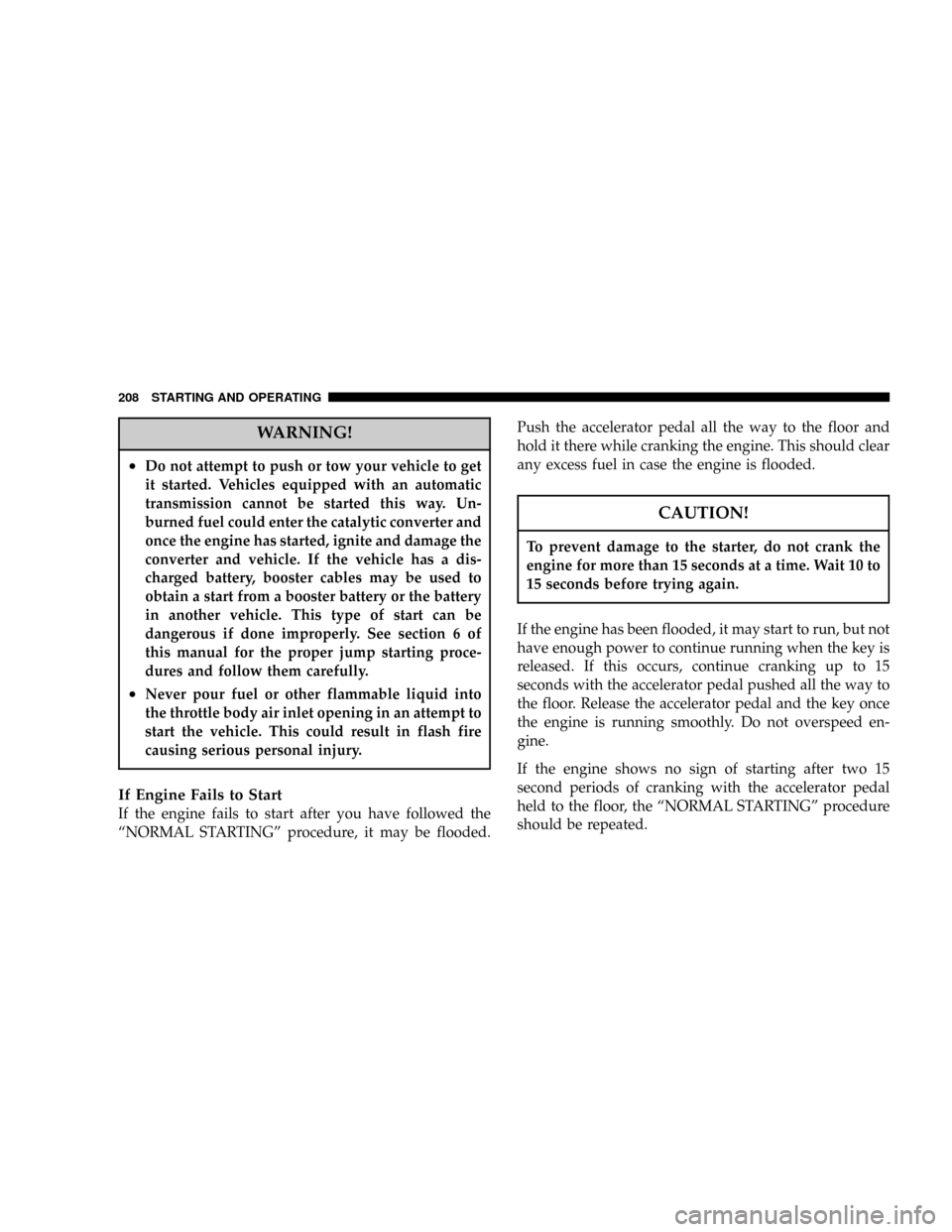Page 208 of 374

WARNING!
²Do not attempt to push or tow your vehicle to get
it started. Vehicles equipped with an automatic
transmission cannot be started this way. Un-
burned fuel could enter the catalytic converter and
once the engine has started, ignite and damage the
converter and vehicle. If the vehicle has a dis-
charged battery, booster cables may be used to
obtain a start from a booster battery or the battery
in another vehicle. This type of start can be
dangerous if done improperly. See section 6 of
this manual for the proper jump starting proce-
dures and follow them carefully.
²Never pour fuel or other flammable liquid into
the throttle body air inlet opening in an attempt to
start the vehicle. This could result in flash fire
causing serious personal injury.
If Engine Fails to Start
If the engine fails to start after you have followed the
ªNORMAL STARTINGº procedure, it may be flooded.Push the accelerator pedal all the way to the floor and
hold it there while cranking the engine. This should clear
any excess fuel in case the engine is flooded.
CAUTION!
To prevent damage to the starter, do not crank the
engine for more than 15 seconds at a time. Wait 10 to
15 seconds before trying again.
If the engine has been flooded, it may start to run, but not
have enough power to continue running when the key is
released. If this occurs, continue cranking up to 15
seconds with the accelerator pedal pushed all the way to
the floor. Release the accelerator pedal and the key once
the engine is running smoothly. Do not overspeed en-
gine.
If the engine shows no sign of starting after two 15
second periods of cranking with the accelerator pedal
held to the floor, the ªNORMAL STARTINGº procedure
should be repeated.
208 STARTING AND OPERATING
Page 316 of 374

CAUTION!
²When installing the Power Distribution Center
cover, it is important to ensure the cover is prop-
erly positioned and fully latched. Failure to do so
may allow water to get into the Power Distribu-
tion Center, and possibly result in a electrical
system failure.
²When replacing a blown fuse, it is important to
use only a fuse having the correct amperage
rating. The use of a fuse with a rating other than
indicated may result in a dangerous electrical
system overload. If a properly rated fuse contin-
ues to blow, it indicates a problem in the circuit
that must be corrected.
Front Power Distribution Center Fuses
Cavity Fuse Circuits
1 20 Amp
YellowLeft High Beam Headlight
2 20 Amp
YellowRight High Beam Headlight
3 15 Amp
Dk. BlueAdjustable Pedal
4 20 Amp
YellowHorn
5 25 Amp
ClearHeadlamp Washer Ð If
Equipped
6 15 Amp
Dk. BlueFront Control Module (FCM)
7 20 Amp
YellowFog Lamp
8 15 Amp
Dk. BluePark Lamp
9 15 Amp
Dk. BlueNon ABS Brakes
10 5 Amp
OrangeStarter
316 MAINTAINING YOUR VEHICLE
Page 317 of 374
Cavity Fuse Circuits
11 15 Amp
Dk. BlueAuto Shutdown/Powertrain
Control Module (PCM)
12ÐÐ
13ÐÐ
14 20 Amp
YellowPowertrain Control Module
15 20 Amp
YellowInjectors, Ignition Coils
16 20 Amp
YellowPowertrain Control Module
17 30 Amp
PinkAntilock Brake System (ABS)
Valves
18 30 Amp
PinkWindshield Wiper/Washer
19 50 Amp
RedRadiator FanCavity Fuse Circuits
20 20 Amp
Lt. BlueStarter
21 50 Amp
RedABS Pump Motor
22 40 Amp
GreenRadiator Fan High/Low
23 50 Amp
RedHigh Intensity Lighting
24ÐÐ
25 30 Amp
PinkLighting Left High Beam/
Right Low Beam
26 20 Amp
Lt. BlueTransmission
27 30 Amp
PinkLighting Left Low Beam/
Right High Beam
MAINTAINING YOUR VEHICLE 317
7